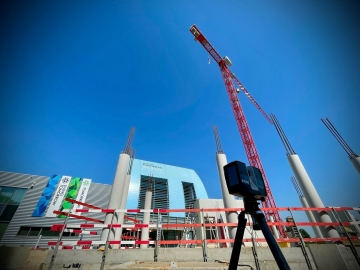Scanbie and Living Tomorrow conceive digital twin to track new campus building

As a partner of Living Tomorrow, Scanbie will be responsible for the development of a digital version – a digital twin - of the new campus. At very regular intervals, the construction process will be digitally mapped via 3D laser scanning. Sensors will collect real-time data which can create predictive simulations.
As a partner of Living Tomorrow, Scanbie will be responsible for the development of a digital version – a digital twin - of the new campus. At very regular intervals, the construction process will be digitally mapped via 3D laser scanning. Sensors will collect real-time data which can create predictive simulations.
Retroactive scanning to predict the future
As a partner of Living Tomorrow, Scanbie will be responsible for the development of a digital version – a digital twin - of the new campus. At very regular intervals, the construction process will be digitally mapped via 3D laser scanning. Sensors will collect real-time data which can create predictive simulations.
In this way it becomes possible to better understand how the building will perform in the moment and into the future. One of the objectives is to expand the 3D model in such a way that operational data can be linked to the model to provide a comprehensive integrated solution.
This periodic approach facilitates the seamless digitization of the entire construction process, allowing retroactive progress through the different phases of the entire construction process even after the construction project has been completed. It offers endless options. For example, one could review the 'windproof' delivery phase in detail at any time. Or investigate and measure the placement of pipes, view specific parts in the building, add information, …
Better insights, efficient optimization
Incorporating real data in such models does not only create models that become increasingly realistic. Refining the models also provides an increasingly better insight into the phenomena that affect a building in the real world. With this knowledge, people can start optimizing and improving real processes. For Living Tomorrow, the digital twin forms a virtual base from which it will develop many of its future activities: simulations, communication, control, maintenance, …
In addition, also various partners of Living Tomorrow will benefit from the system, by example through simulations, demonstrations or network eventing.
Flawless integration of the IoT
One of the aims of this digital twin is also the integration of the IoT sensors that are already present in the building, enabling even more efficient analyzes and simulations. Many smart devices will play a key role as embedded information and communication technology has the potential to revolutionize the efficient use of countless everyday objects.
The use of digital twins is still unknown to many. Yet it is undeniably one of the most important digital evolutions of the future. That is why the new Living Tomorrow campus is the ideal place to introduce visitors to this 'guardian angel in the cloud'.
Latest insights & stories

A Global Movement: The World Unites in a Pink Pledge for Clean and Sustainable Water
5,000 participants. 32 countries. €30,000 funds raised. And that's just the beginning.
Picture this: One step that sends ripples across the globe, transforming lives and creating waves of change. You might wonder, how can such a simple action for most of us have such a profound impact?

Sustainability and circularity in construction
Join us in transforming the future of construction, creating buildings that not only stand the test of time but also contribute to a healthier planet!

RainTunes: Shower scenarios for the soul
Light, hearing, smell, and touch: Together with experts, we have developed sensuous scenarios that turn showering into an individual experience. Whether you want to prepare for the day ahead or relax after working out. Whether you want to refresh after a day’s work or unwind at the end of the evening: RainTunes surprises with multisensory experiences.*
*Currently available only in Germany and Austria.